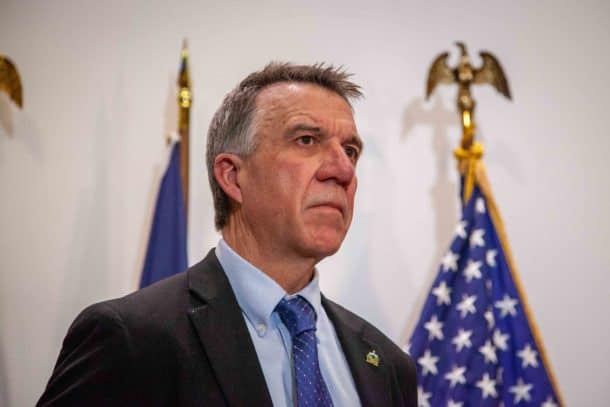By Polly Mikula
Vermont is just days away from hitting its threshold to remove all Covid-related health restrictions, state officials said Tuesday, June 1. When 80% of the state’s eligible population is vaccinated (one dose administered to residents 12 years old or older) then the remaining mandated protocols for masking and distancing will be removed.
Saturday, May 29, Scott lifted the 10 p.m. curfew imposed on bars, restaurants and social clubs — all can all now go back to regular hours. However, the social distancing requirements will stay in place until the general emergency orders are lifted.
As of Saturday, 78% of Vermonters had been vaccinated — 433,322 total — with 11,346 more needed to reach 80%. Vaccinations administered on Sunday and Memorial Day Monday were not yet factored in as of Tuesday mid-day, but weren’t expected to be high enough to hit the state’s goal.
“The number of Vermonters vaccinated each day will determine how soon the state will reach 80% and can fully reopen,” said Mike Smith, secretary of the Agency of Human Services. “If 1,000 Vermonters get vaccinated each day, it is projected that we will fully reopen on June 11. If 1,500 Vermonters are vaccinated each day then the reopening will move up to June 7. And if 2,000 a day are vaccinated then the reopening day would be June 5,” he said.
Last week the state and the CDC discovered that about 15,778 vaccinations had been double counted. The department of financial regulation (DFR) has corrected its data but the CDC’s tally won’t be fully adjusted until later this week. “It will take a few days for CDC records to match our records,” Smith said.
“According to data from the CDC and adjusted by DFR the seven day vaccination average was 2,500 Vermonters until the week of May 25. That would have put us on pace to reach our goal on or before June 5, but in recent days that daily number has dropped off demonstrating a slowdown — to 1,446 on Friday and 1,509 on Saturday,” Smith said.
Despite the correction, Vermont continues to lead nation in its vaccination rate and low case numbers. The state also hasn’t had a single Covid-19 death in over two weeks — the only state with that claim, Governor Phil Scott said, Tuesday. “But we’re not declaring victory, yet. We still need folks to step up.”
This week there are over 100 opportunities for people to walk-in and get vaccinated, with 39 pop-up clinics scheduled Tuesday through Sunday, Scott said. A walk-in clinic was held at Killington Resort, Tuesday, June 1, and Rutland Regional Medical Center will host clinics June 2-6 at the Holiday Inn Conference center at 476 Holiday Dr., from 7-11:50 a.m. offering the Pfizer vaccine. Visit healthvermont.gov/covid-19/vaccine for a complete list of walk-in clinics or to make an appointment.
“We will make every effort to bring the vaccine to Vermonters where they live, work and play,” Smith said. “All Vermonters need to do is show up and get their shot.”
“We will continue to do this so that access not a barrier,” said Scott.
“The response of Vermonters has been simply amazing in protecting themselves, their families and friends, and fellow Vermonters — we just need a few more to reach our goal,” Smith added.
Low Covid cases
“Today, with the country’s lowest case rate, the lowest hospitalization rate, the lowest fatality rate, and the highest vaccination rate, Vermont is again the safest state in the country from the risks of Covid-19,” said Mike Pieciak, commissioner of financial regulation. “We anticipate these favorable trends will continue into the foreseeable future.”
“We had just 92 cases this week, 129 fewer than last week,” he said. “To illustrate how quickly these rates are falling, just three weeks ago on May 7 we had 99 cases in a single day… since April 1 we’ve seen a 93% decrease in the seven-day average and this past week we saw a 57% decrease from the seven day average,” he said.
These positive trends are happening while mobility data has recently skyrocketed — surpassing pre-pandemic movement baselines for retail and recreation, grocery and pharmacy, and residential categories, Pieciak added. The only category that has not rebounded is workplace mobility as fewer Vermonters are commuting to their jobs.
“Vermonters are now spending less time at home than anytime in the past 14 months,” Pieciak said. “Increased movement, while seeing dramatic improvement with decrease cases proves the promise of the vaccine’s efficacy,” he summarized.
“This is why we can lift these restrictions, because we trust the vaccine to protect us,” said Dr. Mark Levine, state health commissioner. “We trust the data and the science that says it works to protect ourselves and lowers any chance of the virus spreading — it stops the train of transmission, protecting others, too.”
“When we trust the vaccine we can go out without masks and distancing and we live our lives with fewer Covid-restrictions,” Levine continued. “But for public health, meeting our 80% goal does not mean our work stops. We will continue our efforts to vaccinate Vermonters and keep a close watch on the data. The higher we can get Vermont’s vaccination rate, the better our chance of truly suppressing the coronavirus in this state as it will have less opportunity to be spread between susceptible persons, meaning less likelihood for mutations and various strains to take hold.”
When asked if the state was considering incentives to motivate more people to seek vaccinations, Levine said, “We’ve gotten to almost 80% with very modest incentives — creemees! … I don’t foresee, as a team, that we’ll get more incentive-driven. We’re exceeding the performance of literally every other state with the step-up-to-the-plate attitude that Vermonters have had, thus far.”




